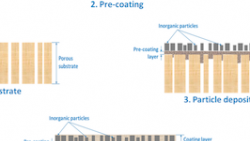
Archived

In view of all these difficulties, large membrane areas are required to handle the huge gas flow and membranes with high permeability is essential to boost the productivity. Until membranes with such characteristics are developed, the implementation of membrane systems in CO2 separation from flue gas seems unlikely.
Mixed-matrix membranes combining the benefits of both polymeric and inorganic materials open a new possibility for membrane gas separation technology in CO2 capture from flue gas. The use of two materials with different permeability and selectivity provides the possibility to better design a membrane for CO2 capture, allowing the synergistic combination of polymer’s easy processability and superior gas separation performance of inorganic materials. Furthermore the addition of inorganic materials in a polymer matrix offers enhanced physical, thermal and mechanical properties for aggressive environments and represents a way to stabilize the polymeric membranes against change in permselectivity with temperature.
The conventional blending technique is the most commonly used approach to prepare the mixed-matrix membrane. One of the major issues with the blending technique is the difficulty to increase the inorganic filler loadings in the mixed-matrix membranes. With low particle loadings, the gas transport behaviour in the membrane structure will still be dominated by the polymer matrix rather than the inorganic fillers. With such concern, a novel layer-by-layer deposition procedure is developed in our lab in order to significantly increase the particle loading without the sacrifice of separation performance.
The layer-by-layer deposition procedure involves three steps:
Separation of CO2 from coal-fired power plant flue gas presents a huge challenge for membrane separation systems, because of;
Archived
Greenhouse Gas Technology